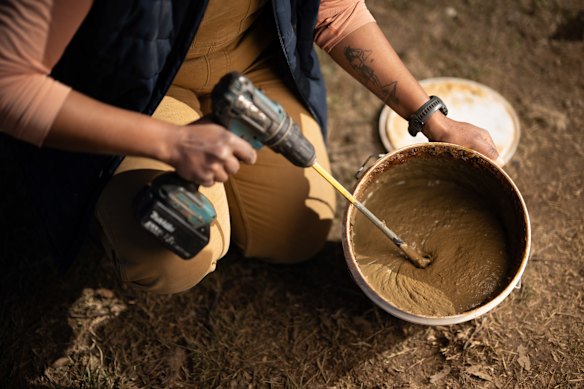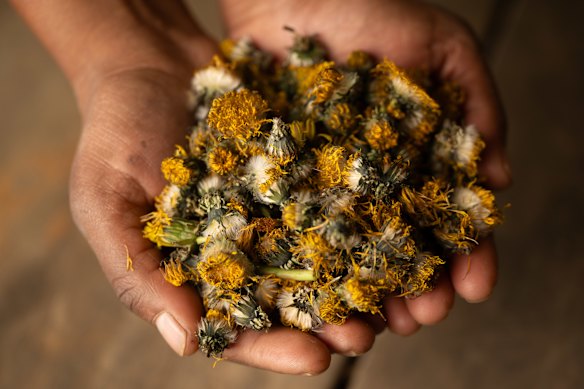He prescribed a series of nine “preparations” to aid farming. The first and most famous, preparation 500, involves spritzing the farm each year with the horn-fermented manure to boost microbial and fungal activity within the soil.
“The manure becomes imbued with growth forces, and it’s really microbially diverse, and it’s beautiful the way it’s transformed,” Mudaly says.
Kesh Mudaly inspecting Block 5 Shiraz bush vines in preparation for pruning.Credit: Wolter Peeters
“It looks nothing like cow manure. It’s a really dark, almost black, colloidal substance, and we use that at about 85 grams to the hectare. It’s quite a potent prep.”
Once the solstice has passed, Mudaly will prune the vines and cover the wounds with a paste made from dung, clay and diatomaceous earth mixed with nettle or casuarina tea.
Other preparations focus on additions to compost, including yarrow stuffed into stag bladders and animal skulls filled with dandelion flowers.
So, does it work?
Loading
One review found that differences between the grapes, juice and wine composition of biodynamic and conventionally made wines were inconsistent. And there’s certainly no definitive science linking lunar phases and plant physiology.
But there are a few intriguing glimmers in the limited scientific press on biodynamics, including findings that suggest biodynamic wines taste better.
“Wines from biodynamically produced fruit were described as more complex, fresh and vibrant compared to conventional wines,” reads one study in academic wine journal Oeno One.
An analysis of 128,182 French wine reviews also found biodynamic drops ranked about 12 per cent higher on average, although most of the ratings weren’t fully blind, meaning reviewers were perhaps prone to unconscious bias.
Organic and biodynamic vines offer 18 per cent less yield compared to conventional vineyards, according to a 2019 systematic review. This may be an advantage, flavour-wise, because smaller bunches of grapes ripen better.

Kesh Mudaly makes biodynamic pruning paste from manure, clay, diatomaceous earth and casuarina tea.Credit: Wolter Peeters
There is some evidence the resulting grapes hold more antioxidant phenols, which influence a wine’s taste and mouthfeel, and flavonoids, which are increasingly linked to longevity. Other studies have reported no significant difference, though, compared to conventionally grown grapes.
On the sustainability side, organic farms, which include biodynamic farms, have 30 per cent more species diversity on average and 50 per cent more organisms according to one meta-analysis. Another four-year field trial on German riesling grapevines found biodynamic soils squirmed with more earthworms and had better fertility than conventional and organic vineyards.
Biodynamic winemaker Chris Carpenter said he adopted the practice at Lark Hill winery near Canberra to enrich the old, depleted, acidic soils so he could grow Austrian grüner vines.

Dandelion flowers used to make preparation 506: part of the compost.Credit: Wolter Peeters
While he believes biodynamic wines are “spectacular” and appreciably different to the conventional stuff, Carpenter takes Steiner’s dogma with a pinch of salt.
“Some of it stands the test of time, and some of it does not at all,” he says.
“That’s probably where I clash with more pure practitioners of biodynamics, in that I prefer to treat it à la carte, and take the good science and the evidence-based stuff and apply that to our vineyards.”
Carpenter is unconvinced, for example, by preparation 501, where ground-up quartz or silica is left in the sun and applied to crops to enhance photosynthesis. “That feels a bit more like homeopathy,” he says.
A recent study, however, found applying silica to cabernet-sauvignon grapes boosted vine growth and resulted in a darker, more opaque red that was more intense in flavour and aroma.
Even if there’s no scientific consensus on biodynamic wines, Australia has the second-highest number of biodynamic farming hectares in the world behind Germany, according to academic Dr John Paull.
And the practitioners swear by it.
“The vines are healthier, they’re stronger, the wines taste better,” Mudaly says. “The proof is in the pudding.”
The Examine newsletter explains and analyses science with a rigorous focus on the evidence. Sign up to get it each week.
Read the full article here
